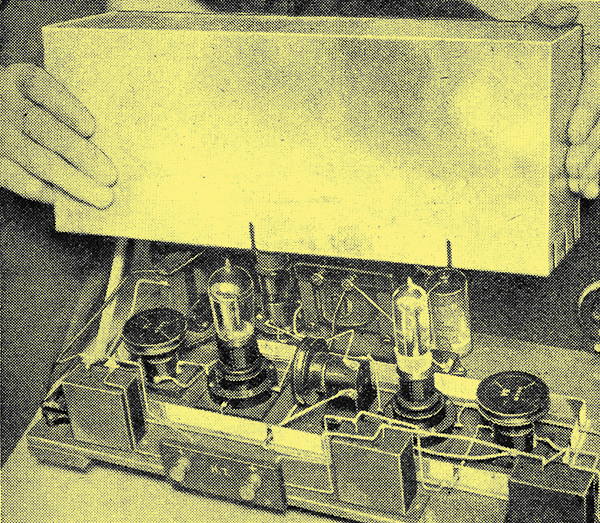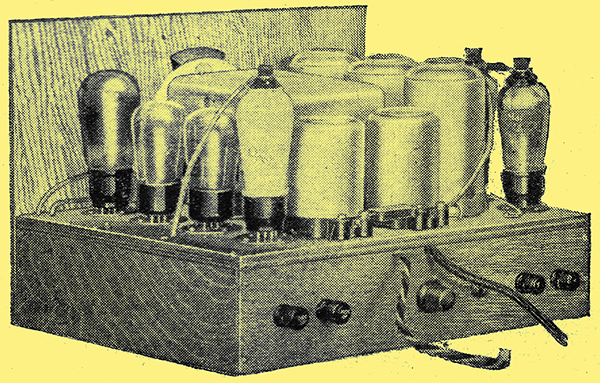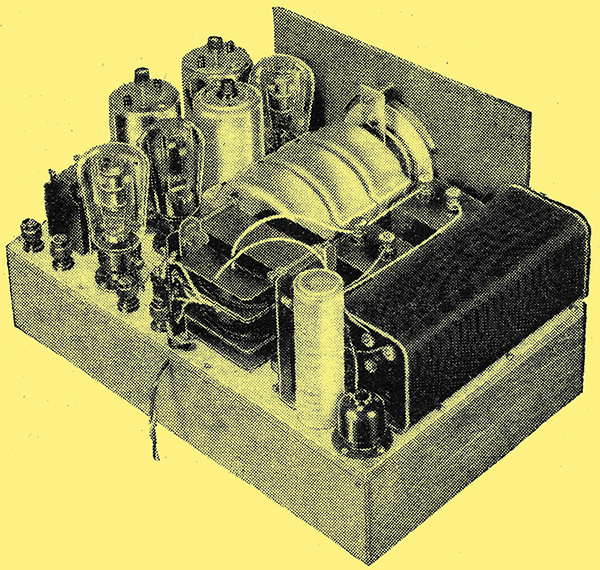|

The IF stages of a superhet described in the pages of this journal during 1925.
Of recent years the superheterodyne has developed so rapidly that it may seem as if finality has been reached. An examination of the question, however, shows that this is not so, and a review of past history indicates the possibility of further advances. The author traces the progress made in the last decade and suggests the lines on which future research may develop.
Ten years ago the superheterodyne was one of the most popular receivers, and it formed the chief standby of serious experimenters; it was, in fact, considered the. ideal receiver, and it was usually spoken of as the Rolls-Royce of radio. Nevertheless, it was doomed to ,early extinction, and, within a few years, the superheterodyne became something of a rarity, and so it remained until its revival by the Wireless World in the autumn of 1930. Since that time, however, it has made rapid strides, and it has earned for itself a popularity far exceeding that which it enjoyed in its early life.
Early Examples
The superheterodyne, therefore, is unusual, for it is not common in wireless for early types of apparatus to be revived in any recognised form, and the modern superheterodyne is identical in its fundamental principles with the first working model. It is interesting, therefore, to examine in some detail the faults of the early superheterodyne which led to its former demise, the reasons which led to its revival, and the developments which are responsible for placing it in its present position of pre-eminence.
The superheterodyne was originally developed because stable and effective high-frequency amplification upon broadcast wavelengths was impossible, and it retained its popularity only as long as such amplification remained impossible. These early receivers were all very similar in. design, and usually eight valves were employed. A two-valve frequency changer was fed directly from a frame aerial, for second-channel interference was then of little importance. Three triodes were normally fitted in the IF amplifier, which was often tuned to 50 kHz and kept stable by the application of positive bias to the amplifiers; a second detector and two transformer-coupled LF stages completed the receiver. The current drawn from the LT battery was often over 6 Amps at 6 Volts, and the demands on the HT battery were also heavy; mains operation was practically unknown, so that the receiver was obviously rather expensive in upkeep.
The sensitivity and selectivity obtainable; were quite high, however, and were really the sole justification for its use, for the sideband cutting of the IF transformers, combined with the distortion introduced by poor LF transformers and overloaded valves, made the receiver notorious for its poor quality of reproduction. No quality is so appalling as that given by a badly designed superheterodyne, and this type of receiver soon became identified with poor quality, and it is undoubtedly largely through this that it fell into disuse. Unfortunately, however, the blame for the poor quality was laid on the superheterodyne principle, rather than on the practical examples of it, with the result that in certain quarters the receiver is still viewed with suspicion. Actually, of course, a properly designed superheterodyne is in no way inferior to a straight set, and is capable of giving equally good quality of reproduction, as has been conclusively proved by recent Wireless World designs.
The development of the Neutrodyne circuit enabled stable and effective high-frequency amplification to be obtained, and sensitive straight sets were introduced. These sets employed fewer valves than the superheterodyne, and they gave better quality, so that it is hardly surprising that their use became general. Consequent upon the later development of the screen-grid valve, the straight set became practically universal, but the superheterodyne was never completely displaced, although it was employed only for special purposes. The year 1929 saw the introduction of band-pass tuning and a consequent improvement in both selectivity and quality. In spite, of this development, however, broadcasting stations were increasing so rapidly in both numbers and power that straight sets were becoming inadequate to deal with the congestion of the ether, and satisfactory distant reception was becoming increasingly difficult. It became abundantly clear that only the superheterodyne could hope to deal with the situation - so far as selectivity was concerned, but there still, remained the grave problem of quality of reproduction. It was soon realised by The Wireless World, however, that the poor quality of the superheterodyne as then known was due merely to poor design, and was in no way fundamental.
Band-pass
As soon as modern principles of LF amplification, power grid detection, and band-pass tuning were fully applied, and the receiver was designed throughout for both quality and selectivity, a startling improvement was evident. All the well-known desirable characteristics of the superheterodyne were found to be still present, but the old bugbear of poor quality had disappeared. In the autumn of 1930, therefore, the first band-pass superheterodyne made its appearance [★] The Band-pass Superheterodyne, The Wireless World, November 5, 1930., and this event is a landmark in the history of wireless, for it marks the beginning of the superheterodyne revival.
Further development was still necessary, however, in order to keep pace with the increasing power of transmitters and to simplify the receiver. It was soon found, desirable to employ an outdoor aerial, and this led to the design of non-radiating frequency changers [★] Frequency Changers, The Wireless World, May 6, 1931., so that quite modest super-heterodynes became a possibility, and a five-valve set could provide sufficient sensitivity [★] The Super-Selective Six, The Wireless World, June 3 & 10, 1931. The Super-Selective Five, The Wireless World, July 15 & 22, 1931. The DC Super-Selective Five, The Wireless World, August 12 & 19, 1931.. Experience showed, however, that there was a definite limit to the amount of intermediate-frequency amplification which could be usefully employed, and if this limit were exceeded background hiss became unduly prominent. In a highly sensitive set, therefore, a return to a signal-frequency HF stage became desirable, although this might still be unnecessary in a receiver of only moderate sensitivity.
Single-dial Control

The Monodial AC Super with AVC.
All this time the superheterodyne lagged behind the straight set in one particular two tuning controls were employed. Ganged tuning could readily be achieved in a straight set, but in a superheterodyne the problem was much more difficult, since the various circuits had to be tuned to different frequencies but still maintain a constant frequency separation as the tuning was varied. Two solutions were eventually found, and the one which has proved the most successful from the constructor's point of view has been that in which a gang capacitor with specially shaped plates is employed.
At the end-of 1931, therefore, the usual superheterodyne operated from an outdoor aerial, and in order to avoid second-channel interference and radiation two pre-selector circuits preceded a non-radiating frequency changer. A single IF stage with band-pass tuning was used, and a power grid second detector fed a pentode output valve. Ganged tuning was just beginning to make its appearance.
The unquestioned superiority of the band-pass filter was then challenged by a rival system the Stenode method of employing highly selective tuned circuits in conjunction with low-frequency tone correction. After much research, a combination of the two methods proved the best, and early in 1932 the Monodial AC Super [★] The Monodial AC Super, The Wireless World, April 12, 20 & 27, 1932. made its appearance. A judicious combination of the bandpass filter with the tone-correction principle permitted a definite improvement in both selectivity and quality of reproduction to be made, while for the first time an entirely satisfactory ganging system made its appearance. A moderate degree of IF amplification with additional signal-frequency HF amplification enabled a very high degree of sensitivity to be obtained without background hiss becoming obtrusive.

The Wireless World Baby Superhet, which has a single valve frequency changer.
The appearance of the Monodial does not mark so much the it culmination of the superheterodyne as the start of a new class of quality superheterodynes. From that time development proceeded on distinct, and yet allied, lines; on the one hand research was conducted ever to the improvement of performance, and, on the other, to the production of a small superheterodyne comparable with the three-valve straight set in every way, except that it would possess much higher selectivity. This latter line led to the Baby Superhet [★] The Baby Superhet, The Wireless World, August 19 & September 2, 1932. a four-valve receiver of moderate sensitivity, good quality, and really good selectivity. At the present time, therefore, we have two entirely different superheterodynes - the Monodial Super and the Baby Superhet - each representing the latest development in its Class. From 1930 to 1933 the superheterodyne development has been rapid and steady, and it is fitting to pause and enquire in what direction the future trend is to be.
In the past the straight set has progressed largely by sudden leaps forward, alternating with periods of stagnation. Whereas the superheterodyne, excepting one period when it fell into disuse, has developed more slowly and steadily. The straight set falls behind the superheterodyne until it is nearly useless in comparison, and then suddenly makes a big stride forward and catches up with it. One such improvement to the straight set has just taken place, the introduction of highly efficient iron-cored tuning coils which has resulted in a vast improvement in selectivity. It may be asked, therefore, whether the straight set may not once more become predominant.
Since superheterodynes now fall into two distinct classes, this question requires two answers; it seems probable that the straight set will now be a serious rival to, or even replace, the small superheterodyne, but it is improbable that it will ever equal, still less surpass, the quality superheterodyne. The selectivity of new straight sets will probably nearly equal that of small superheterodynes, and they will use a valve less, so that in the absence of any new development we may anticipate that the straight set will at least hold its own.
The Future
The case of the quality superheterodyne, however, is entirely different, and it seems unlikely that the same combination of selectivity and quality will ever be as simply attained with the straight set. Many new possibilities are opening out before us, and it seems probable that the superheterodyne of the future will be as great an advance upon present-day technique as modern sets are on those of a few years ago. Developments which appear probable are the general inclusion of ultra-short wavebands in the tuning range, the use of quiet automatic volume control systems, the adoption of iron-cored tuning coils, the employment of metal rectifiers instead of valve detectors, and the inclusion of controllable selectivity and quality, some of these developments will, of course, be applicable to any type of receiver, but others will be practically usable only with the superheterodyne. It should not be expected that these tendencies in design will be soon found; there are many technical difficulties to be overcome before they are realisable in a satisfactory form. Within the next few years we may hope to see most of them.
|